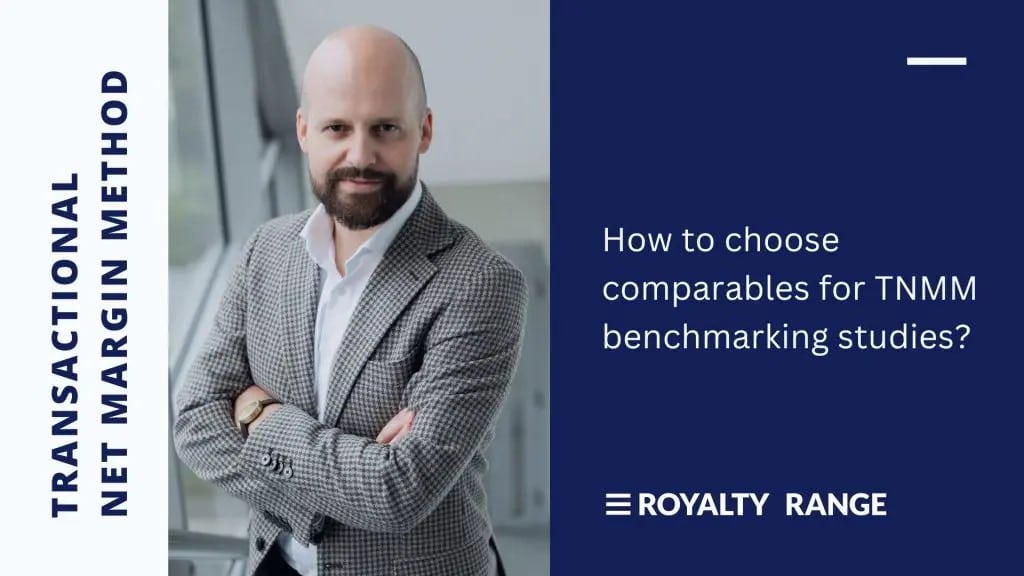TNMM benchmarking: a guide to choosing the right comparables

Lukas Balciunas |
November 15, 2023

How to choose comparables for TNMM benchmarking studies
For transfer pricing professionals, it’s imperative to have a thorough understanding of the different methods for calculating fair prices and when to apply them. Here, we’ll provide an overview of the key concepts for the Transactional Net Margin Method (TNMM), one of the key transfer pricing methods. We’ll go over when and why to use this method, as well as explain the role of comparables and answer frequently asked questions about the TNMM.
What is the Transactional Net Margin Method (TNMM)?
The Transactional Net Margin Method (TNMM) is one of the key transfer pricing methods endorsed by the Organisation for Economic Co-operation and Development (OECD) and used by multinational corporations and tax authorities around the world to determine the appropriate pricing for transactions between related entities in different tax jurisdictions.
The TNMM is specifically designed to assess the transfer pricing of transactions involving tangible goods, services, or intangible property, where the focus is on the net profit margin.
When to use it
This method is considered suitable for transactions involving routine functions and relatively low-risk activities. It is favoured in cases where it may be challenging to find direct comparables for complex transactions, as it focuses on profit margins rather than specific pricing points.
Why use it
When it’s challenging to find direct comparables for complex transactions, the TNMM provides flexibility in selecting companies that closely resemble the controlled transaction. It’s also one of the transfer pricing methods approved by the OECD, so if you do use it, you do not need to provide any additional documentation concerning your choice of method, streamlining contracts.
However, implementing the TNMM can be complex, as it requires access to reliable financial data, careful selection of comparables, and thorough analysis. Furthermore, transfer pricing regulations and guidelines vary from one country to another, and multinational enterprises must ensure compliance with the specific rules and documentation requirements in each jurisdiction where they operate.
What is TNMM benchmarking and when do you need to use it?
TNMM benchmarking involves comparing the net profit margin of a tested party engaged in controlled transactions with the net profit margin of comparable uncontrolled entities. The goal here is to determine whether the net profit margin of the tested party is within the arm’s length range.
To conduct a benchmarking study, you must identify the tested party, choose an appropriate Profit Level Indicator (PLI), collect relevant financial data, and finally, determine an arm’s length range. Comprehensive documentation will be needed to support your findings and comply with transfer pricing regulations.
We’ll now go into more depth on the role of comparables – why they’re important, how to choose them, and how to search for them.
The role of comparables
Comparables, also known as “comparable companies” or “comparable transactions,” are critical to the TNMM process. They serve as the basis for determining whether the profit margin of the controlled transaction is at arm’s length. Comparables help establish a benchmark against which the controlled transaction is evaluated.
Selecting relevant comparables
Selecting relevant comparables is a crucial step in TNMM benchmarking. The goal is to identify companies or transactions that are as similar as possible to the controlled transaction in terms of industry, product, geographic location, and other relevant factors.
Search for comparables
Use various sources, including commercial databases, industry reports, and public financial statements, to identify potential comparable companies or transactions.
Using a company financials database
A company financials database, like the one provided by RoyaltyRange, is an invaluable resource for TNMM benchmarking.
RoyaltyRange offers a comprehensive database containing financial information crucial for transfer pricing analysis, aiding users in determining arm’s length pricing for intercompany transactions.
The database includes financial statements of multinational companies, facilitating the selection of comparable companies for benchmarking purposes. It allows users to search, filter, and analyse financial data to ensure accurate and compliant transfer pricing decisions.
This resource is particularly valuable for tax professionals, providing access to a wide range of financial metrics and facilitating the normalisation of data to enhance comparability. RoyaltyRange’s company financials database aims to streamline the complex process of transfer pricing, supporting users in making informed decisions and maintaining compliance with international regulations.
FAQs
What is the main objective of TNMM benchmarking?
The goal of TNMM benchmarking is to ensure that the net profit margin of the controlled transaction falls within an acceptable range (the arm’s length range) determined by the net profit margins of comparable uncontrolled transactions. Exact matching is not always feasible or necessary.
Are identical companies required for TNMM benchmarking?
It is not necessary for the comparable companies to be identical in every aspect to the controlled entity. While similarity is essential, there can be differences between the controlled entity and comparables as long as those differences are adequately accounted for through adjustments. The goal is to select comparables that are as similar as possible in terms of industry, functions, risks, and other relevant factors.
Can I use industry averages for TNMM benchmarking?
Using industry averages as a benchmark for TNMM is generally not recommended. Industry averages may not reflect the specific characteristics of the controlled transaction or the functions and risks undertaken by the taxpayer. It’s important to use transaction-specific data and select comparables that closely resemble the controlled transaction.
How many comparables are needed for TNMM benchmarking?
There is no fixed number of comparables required for TNMM benchmarking. The focus should be on selecting the most reliable and relevant comparables, even if it’s a small number.
Do currency differences matter in TNMM benchmarking?
Currency differences can be important in TNMM benchmarking, especially if the controlled transaction and comparables operate in different currencies. It may be necessary to convert financial data into a common currency using appropriate exchange rates. Additionally, exchange rate fluctuations can affect profit margins, so it’s important to consider this when making adjustments or interpreting results.
These FAQs highlight the importance of approaching TNMM benchmarking with a clear understanding of its principles, and the need for careful consideration of relevant factors in the selection of comparables and data analysis.
Premium-quality data for all your transfer pricing needs
Trusted by multinational enterprises, global consulting companies, international law firms and tax authorities in more than 70 countries, RoyaltyRange’s range of tools and databases cover private company financials and ownership information, royalty rates, loan interest rates and service fees – everything you need for transfer pricing, financial transaction benchmarking, royalty rates and service fees benchmarking, valuation of intangibles and purchase price allocations, sales and marketing lead generation and automation, procurement and client onboarding, and KYC/AML procedures.
Kris Rudzika, Managing Partner at RoyaltyRange, says:
“RoyaltyRange’s company financials database empowers transfer pricing professionals with a comprehensive toolkit for precise and compliant decision-making. Our database, rich with multinational companies’ financial data, has the ability to search, filter, and analyse financial statements. We believe in simplifying complexity, providing a user-friendly solution that enhances accuracy and efficiency. Our company financials database is a catalyst for well-informed transfer pricing decisions, ensuring businesses navigate the complexities of international regulations with ease.”
You can find out more about our databases and tools here. Simply get in touch to request a live demo or trial access, or get started straight away by entering your search criteria in the One Search form.
The information provided below is for general informational purposes only and should not be construed as legal or tax advice. It is not a substitute for consulting with a qualified legal or tax professional.
Request One Search
We will perform the search and deliver the initial results within hours, at no cost.




